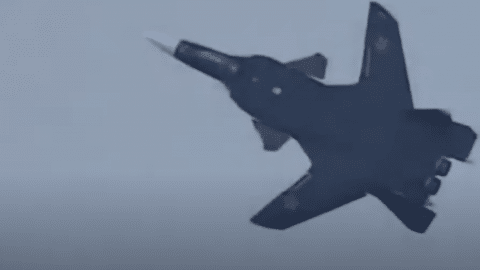
YouTube / Dark Skies
In the 1980s, the Soviet Union was on a quest to develop their own 5th-generation aircraft – able to dominate the skies and outmatch every American fighter in the market.
Sukhoi’s new aircraft design was intended to be a companion to the Yakovlev Yak-141 VTOL aircraft and was originally dubbed the Sukhoi Su-22, but this was later changed to Su-27KM to confuse American spies.

But while Sukhoi began work, the Soviet Union’s collapse during those times led to many cuts in military projects. In 1988, the program was canceled and archived.
Still, the forward-swept wings were far too good to be set aside just like that. By the late 1990s, the Russian Ministry of Defense retook the program and gave Sukhoi the go-ahead in development.

By 1997, the aircraft prototype was ready to take to the skies for the first time.
The testbed was dubbed “Su-47 Berkut” or “Golden Eagle.” It measured 22m in length, 6.3m in height, and a width of 15m. The design had a max takeoff weight of 35,000 lbs, with its fuselage being made of composite materials, aluminum, and titanium alloys.

Using forward-swept wings provided Berkut excellent maneuverability at subsonic speeds, better angles of attack, reduced radar signature, and reduced landing and takeoff rolls.
It was fitted with two Perm Aviadvigatel D-30F6 turboshaft engines, giving off 18,700 lbs of thrust and a max of 32,000 lbs with afterburner. The Berkut could easily achieve a max speed of over 1,066 mph and had an outstanding cruise speed of 870 mph.

Although its designers were initially worried about every crunch they heard from its wings, the composite materials they used were able to contain the stress put into the aircraft.
However, the Russian Air Force decided to ditch the aircraft.
The forward-swept wings were prone to unrecoverable stall instability and potential wing failure from aeroelastic twisting. Advancements in thrust-vectoring technology resulted in maneuverability gains similar to those of swept wings but without any shortcomings.

Despite its many shortcomings, the Su-47 Berkut still had much to offer. It became a flying laboratory to test new tech incorporated into future aircraft. Additionally, it was used to test prototypes of the internal weapons bay of the Su-57.